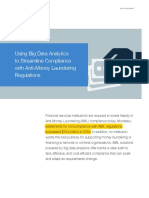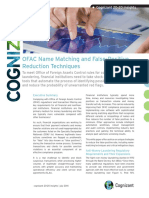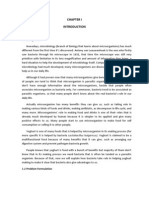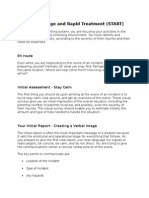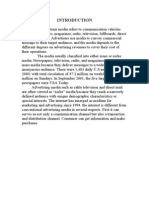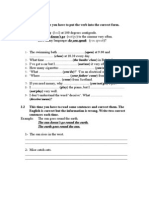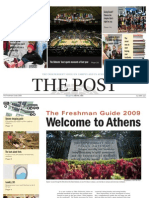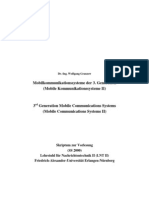Efficient Client Onboarding The Key To Empowering Banks PDF
Efficient Client Onboarding The Key To Empowering Banks PDF
Uploaded by
saumilshuklaCopyright:
Available Formats
Efficient Client Onboarding The Key To Empowering Banks PDF
Efficient Client Onboarding The Key To Empowering Banks PDF
Uploaded by
saumilshuklaOriginal Title
Copyright
Available Formats
Share this document
Did you find this document useful?
Is this content inappropriate?
Copyright:
Available Formats
Efficient Client Onboarding The Key To Empowering Banks PDF
Efficient Client Onboarding The Key To Empowering Banks PDF
Uploaded by
saumilshuklaCopyright:
Available Formats
• Cognizant 20-20 Insights
Efficient Client Onboarding:
The Key to Empowering Banks
Client onboarding is one of the most critical functions for banks as
it directly impacts client experience, servicing and relationships —
all of which, in turn, impact profits.
Executive Summary touch point — the “client onboarding” process
— has emerged as a vital client service differen-
Client onboarding is emerging as a major focal
tiator. Banks’ infrastructure for client onboarding
point for banks and financial institutions, which
has therefore become a focal point for CIOs in
are grappling with evolving market dynamics, stiff
terms of cost, capacity, productivity and opera-
competition, regulatory scrutiny and operational
tional efficiencies.
overheads. This area offers banks an opportunity
to expand to new geographies, acquire newer and From a business perspective the client onboarding
stronger businesses and establish themselves as function is extremely complex, given differing
best in class. Banks therefore need to streamline local regulations and the lengthy negotiations
the onboarding process and offer a customized and documentation requirements involved.
client service. Moreover, the onboarding process for the clients
as active counterparties in a multiproduct trading
In response to regulatory trends and require-
relationship is constrained by product-based silos.
ments, banks are shifting away from proprietary
In many instances the same client needs to be
trading toward flow business. Investment banks
onboarded for each asset class, as the underlying
and prime brokers must therefore focus more
systems are not integrated. Even for a single asset
on how they onboard, understand and treat
class, many systems are used for onboarding —
their clients. Numerous regulations from the
depending on the sophistication and coverage
Foreign Account Tax Compliance Act (FATCA) to
required for a particular client. These disparate
the Markets in Financial Instruments Directive
systems result in longer onboarding cycles. Also,
II (MiFID-II) have forced banks to revisit their
the lure of an immediate “trading opportunity”
client acquisition and relationship management
often prompts the front office or middle office
processes. In the face of tightening margins and
to use a patchwork of the systems involved. This
increased or flat costs of trade processing and
risks compromising the integrity and comprehen-
operations, client service has gained significant
siveness of critical client data.
importance. Additionally, firm-level auditing and
reporting has drawn attention to “know your The process for a client to be formally onboarded
customer” (KYC). Consequently, the first client and start doing business with a bank can
cognizant 20-20 insights | february 2013
take several days or weeks as a result of the In a typical investment banking organization,
challenges outlined above. The process is rarely the sales/front office/marketer liaises with the
structured to provide a relationship-centric view; client and begins the client acquisition process
it is considered a routine, insignificant activity. by initiating an onboarding request. Typically,
Inefficient onboarding can often lead to client the dedicated onboarding team takes ownership
attrition and missed oppor- of the onboarding request and engages with
Typically, the tunities for growth and cross- other departments to process the request. Once
selling. Losing a client has the the relevant client details and documents are
dedicated onboarding obvious impact on a bank’s gathered, processes such as compliance, credit
team takes ownership reputation and hampers new and legal need to follow to ensure that identi-
of the onboarding client acquisitions. fication checks are complete, credit lines are
established and legal agreements are negotiated.
request and A report from Aite Group Eventually, operations sets up the client account
engages with other suggests that more than in all trading, collateral and settlement systems.
70% of U.S.-based firms view
departments to client onboarding as either
This establishes the client relationship.
process the request. a back-office function that For an existing client, an incremental request (e.g.,
needs to be cost-contained or adding a new party or account) can come through
a front-office automation tool.1 Only 30% viewed various channels such as sales, marketing, CSR or
client onboarding as a competitive differentiator. the onboarding team.
Unsurprisingly, the client onboarding function is
A typical client onboarding lifecycle can be divided
typically underfunded.
into five distinct stages, as shown in Figure 1.
We believe it is crucial for banks to demonstrate
a client-centric focus at each client touch point in Challenges
order to secure a competitive advantage. Banks face a number of hurdles in establishing
an efficient client onboarding framework. Our
Client Onboarding Process analysis indicates that these hurdles mainly come
Client onboarding involves several important under four streams: people, process, system
activities such as evaluating new clients, and data.
setting up credit process compliance, ensuring
People
agreement on legal terms, opening of a new
account and making the client “trading enabled” Often client onboarding is viewed as a routine
in line with the bank’s business policy as well as process and not as an enormous opportunity
industry regulations. to build relationships. Consequently, there is no
focus on efficiency and scaling up.
Client Onboarding Process
Set Up
Onboarding Client Due Credit Terms Agreement Party/Accounts
Request Diligence Setup Management in Systems
• Gather client details. • Perform credit due • Negotiate legal • Complete account
• Solicit client.
• Identify and request diligence. terms. setup.
• Raise new
relevant client • Establish credit limits • Execute legal • Enable product
onboarding request.
documentation. as appropriate. agreements (e.g., trading.
• Enrich request.
• Perform regulatory • Assess and manage ISDA, CSA, etc.). • Send ”ready to
• Manage incremental trade” notification
AML and KYC additional credit risk • Complete legal
request for existing to trading desk.
due diligence. element for high net due diligence.
client.
• Complete additional worth clients.
client ID, document
checks (geographic
specific) and approve.
Sales/FO/Marketer KYC Credit Legal Operations
Figure 1
cognizant 20-20 insights 2
Often an onboarding team may lack a sense of of defined client attributes and inconsistent
ownership. For example, the team may assume hierarchy. The lack of unique client identifiers
that ensuring clarity in the contract documen- for onboarding and incorrect mapping between
tation is solely the legal team’s responsibility. A source and downstream systems are also a
lack of shared objectives and information sharing problem. These have a cascading impact and
between the front office and back office results in result in manual rework, long turnaround times
bottlenecks that compromise the level of service and inaccurate and inconsistent data.
provided to clients. Often the different teams
involved in client onboarding are not motivated A Way Forward
to collaborate and there is no revenue-sharing Governance
model in place. As client onboarding is primarily a coordination
function, it encounters many governance issues. It
Process
is therefore imperative to establish a governance
Many banks still have fragmented processes body to provide leadership and oversight for
that prevent a seamless onboarding function. the program while also supervising ”business as
For example, the client onboarding requests usual” activities.
can come through different channels of a bank.
Often the onboarding process involves several The first step would be to
e-mails, paper documents and faxes as well as establish a client onboarding The absence of a
frequent manual intervention. For the client, the leadership team. This team flexible or scalable IT
absence of clear information on the status of the can define KPIs, incentive platform to onboard
onboarding becomes frustrating. This opacity is structure, points of contact
due to the lack of a centralized view of a client, (PoCs), SLAs and the clients has been
which can lead to potential fallouts such as escalation path. The next a major roadblock
incorrect account relationships being set up, and step should be to align a leading to operational
inaccurate mapping, which, in turn, can cause an working group to each of
internal loss for the bank. the functional work streams breaks in the client
— e.g., KYC, credit, legal, etc. onboarding flow.
System This will enable the banks
The absence of a flexible or scalable IT platform to assign ownership and focus on accountability
to onboard clients has been a major roadblock through clear milestones. Additionally, through
leading to operational breaks in the client ongoing financial health checks and information
onboarding flow. For instance, many banks suffer exchange, banks will be able to move away from
from a lack of synchronization among multiple a traditional siloed approach to a functionally
systems. Several banks still operate with e-mails unified client-centric governance model.
and faxes, without any automation to facilitate
faster onboarding. Overall, the lack of automation The governance team should define the key
creates an inconsistent user experience across principles underpinning the client onboarding
touch points and reduces efficiency significantly. process. Figure 3 is an illustrative example of key
principles.
Data
The lack of a defined “golden source” for client Client Onboarding Data Framework
data is often a prominent issue for banks as they A major driver for establishing automation,
continue to operate across siloed data sources. efficiency and streamlining of processes is the
Additionally, banks often struggle with the lack availability of clean data.
Client Onboarding Proposed Solution
Document
Governance Client Onboarding Client Onboarding Entitlements Client Onboarding
Management Dashboard
Data Framework Work Flow
Facility
Figure 2
cognizant 20-20 insights 3
Client Onboarding Principles
Category Principle
A consistent client experience should be achieved throughout the onboarding
Client Touch Point
process.
The controls should be independent from front-office influence.
Process Controls There should be segregation of duties, owners and users.
The controls should be integrated in the business flow.
An interaction mechanism should be defined to facilitate discussion with a
People
diverse set of stakeholders to understand their feedback.
Processes should be automated wherever possible.
Supporting Technology The IT infrastructure to support the guiding principles should be continually
upgraded.
A golden source of client data should be defined.
Data Quality
Information should be correct up front to facilitate clean data downstream.
Figure 3
Focus on Client Data and Key Client Attributes Define Client Data “Golden Source”
As we highlighted earlier, the lack of proper A holistic view of a client’s activities requires a
definition of client reference data and the absence “golden source” for client data. As client data
of a single operating model for client data and is often obtained through a number of diverse
information are common problems among banks. methods using a variety of tools or source systems
across different geographical regions, there
To tackle data-related problems, it is vital to is a clear need for a client data repository. We
define and capture all client data information and believe this need can be served through a client
attributes. Banks need to define their own set of onboarding “master database.” Such a database
key client data attributes as a first step in client should consist of the following elements:
data management. The scope can be expanded
further to define metadata attributes focusing • Standard client hierarchy: The client
on the client’s risk profile and trading prefer- hierarchy used by different teams at the same
ences, etc. at a granular level. A sound metadata bank is often inconsistent. Figure 5 depicts a
management structure covering all areas will typical client hierarchy in a bank which is struc-
enable banks to segment clients appropriately tured in descending levels as Parent¬Group¬
and extend additional service offerings. Fund¬Account¬Subaccount. The complexity
Key Client Attributes
Unique Client ID Listing and Regulation Status
Account Document
Hierarchy for Sales,
Registered/Trading Address
Credit, Reporting, etc. Client
Institution Type Transaction System IDs
Legal Name Tax Identification
AML/FSA Classification
Figure 4
cognizant 20-20 insights 4
Standard Client Hierarchy
Client Legal Entity Parent Level
Client Business Unit 1 Client Business Unit 2 Group Level
Client Fund Level
Account 1 Account 2 Account Level
Subaccount Subaccount Level
Figure 5
arises when different teams use and refer to linked to downstream systems for consistent
the client hierarchy according to their modus mapping. This will ensure smooth data flow and
operandi. For example, trading views Dodd- enable tracing client data/information from
Frank Legal identifier at the topmost level, source to destination.
while the sales team maintains the relationship
with the client at the “group” level. Similarly,
• Ability to support draft, prospective,
suspended and inactive statuses: The client
while the prime services team is engaged at onboarding master database should be able
“fund” and “account” levels, the settlement to support different statuses during the client
and operations team is engaged with the activity lifecycle. For instance, if the client
“account” and “subaccount” levels. Therefore decides to move away then the inactive status
a harmonization of the hierarchy levels of must be reflected and should be properly com-
interest and concern should be driven from municated to stakeholders and downstream to
the top, with consistent definition and usage of enable appropriate actions in terms of termina-
levels and relationships to be maintained in the tion and product disablement.
onboarding master database. The hierarchy
should be based on a unique legal entity iden- Client Onboarding Workflow
tifier (internal) and/or potentially on the legal We believe a harmonized and robust workflow is
entity identifier (LEI) mandated by Dodd-Frank essential. It should focus on key activities such
to enable compliance with requests at the as separation of global
counterparty level in a timely manner. and local components and
Many clients express
• Client identifier as a primary key for the separation of processing
onboarding process: Additionally, banks often and servicing by identi- annoyance with having
use multiple source identifiers (BIC, Reuters fying relevant processes to deal with a bank
and subprocesses, and by
code, Bloomberg, etc.) for the same client.
minimizing manual inputs
that has different
All these client identifiers need to be cross-
mapped between applications to facilitate and variations. An approach processes for the
both onboarding and processing of the client’s to establishing a robust various countries it
onboarding workflow could
trading needs.
be as follows:
operates in.
• Cross-references to alternative identifiers
within the client onboarding (COB) framework: Process Standardization
Several downstream systems require client
Many clients express annoyance with having to
data to be processed at the transaction level.
deal with a bank that has different processes
Therefore a “unique client identifier” in the
for the various countries it operates in. Process
client onboarding master database should be
cognizant 20-20 insights 5
standardization can deliver significant benefits • Ability to plug in new applications following
and contribute to improving the overall client process standardization and application ratio-
experience. In order to accomplish this success- nalization.
fully, banks can follow the following steps:
• Adaptability to use a service-oriented appli-
• Ensure that processes and subprocesses have cation to build a componentized model and
been correctly defined in line with onboarding maximize service exposure and workflow
needs across different areas of the business. enablement.
• Identify manual operations and inputs such as Build an Intelligent Rules Engine
relevant tax documentation.
An intelligent rules engine should have provisions
• Eliminate/automate manual operations where to build rules for workflow and other service
feasible. components for processing. This is highly
• Identify processes that can be globalized such desirable, as a client onboarding portal linked to
as reference data setup. workflow and the rules engine will allow efficient
client data validation, approval and attribute
• Identify processes that can be localized such as capturing to be built into the system easily. This
credit review.
will also create a configurable implementation of
• Optimizeprocesses with parallel processing, a centralized account workflow.
minimizing sequential dependencies.
The most important points to consider are:
Onboarding Application Rationalization
Most banks have different legacy systems under- • A common set of rules should be applied con-
sistently through all components of the archi-
taking similar tasks for client onboarding. For
tecture.
example, the investment banking division may
have multiple applications for client data capture, • There should be validation rules to ensure
data check and validation — all of which can be single point-of-entry for account information.
rationalized. Similarly, banks often use different
mechanisms such as e-mail, intranet, portals,
• The rules engine design should be based on
composable components — i.e., individual
tools or a combination of these to collect and components that provide reusable services.
submit relevant client documents. An application This will offer agility as services can become
rationalization exercise, in this case, can create a part of different solutions in response to
suitable business process platform to deliver this changing requirements.
capability more efficiently. Banks can take the
following initiatives: Optimize and Enhance Automation
A majority of client onboarding problems can
• Define application inventory to trace any over- be eliminated or managed better if banks focus
lapping or duplicate applications that perform
on automation and reduce manual interven-
similar tasks. These applications are candidates
tion. It will help ensure timely completion of the
for consolidation or elimination.
process and the availability of accurate data. Our
• Conduct application evaluation to select appli- experience suggests banks need to focus on the
cations based on the actual business need. following:
Establish a Robust Workflow • Replace manual functions with automated
The ideal workflow should have: tools.
• Context that dynamically adapts to business • Revisit the batch processes and feeds to
rules. assess feasibility of automation and fast data
propagation.
• A dynamic user interface that can be
customized to offer geography-specific views. • Minimize manual reconciliation and data break
checks in the touch points through automated
• Ability to support “draft status” of onboarding exception management.
until data is available to move work further
downstream. • Implement distribution matrix and client data
distribution policies.
• Abilityto capture priority management and
audit trails. • Develop a real-time messaging interface to
pass on relevant client data.
cognizant 20-20 insights 6
Entitlements Document Management Facility
With strict data secrecy and data protection Onboarding documentation management can
rules put in place by different regulators, there be a frustrating process both from a client per-
is a growing need to maintain data integrity and spective as well as from the bank’s point of view.
prevent bypassing of the entitlement process. In Below we outline a more structured approach to
order to ensure that client onboarding is tightly document management.
controlled, banks must emphasize the importance
of entitlements. The entitlement layer should be Identify Specific Document Requirements
implemented so as to ensure the following: The first step to streamlining client documen-
tation during onboarding is to define what is
• The entitlement layer must be able to separate required. The COB team should define a master list
role entitlements and data entitlements.
of client document requirements for onboarding
• It should address corporate and local (geo- and then contact clients. This will ensure that
graphical) regulatory requirements for data the COB team controls the master document and
privacy, security and protection. that there is no communication from KYC, legal
or other groups to clients asking for additional
• It should define client data access, ownership, documentation.
usage and storage.
• It should also consider specific regional data Improve Document Processing and
entitlement requirements as there are often Management
regional regulations (e.g., Swiss banking and The next step is to take measures to institution-
other European mandates) to be considered. alize the document management process. We
recommend the following approach:
Additionally, client data validation and enrichment
should be closely monitored. This will ensure • Establish an authoritative source of parameter-
that the client data is of high quality and ready ized legal terms that form a foundation for risk
to use. Ongoing control of client data quality management.
and accuracy will not only minimize operational
breaks causing long delays, but will also improve • Build a template library for all documents
required across asset classes, client types and
the overall onboarding performance.
jurisdictions.
Illustrative Entitlement Matrix
Role Entitlement Matrix
Roles Sales COB KYC/Compliance Credit Legal Operations
R–m R–m R–m
R–m R–m R–m
W–- W–- W–-
R – m= Reading W – -= Writing
Data Entitlement Matrix
Attributes Sales COB KYC/Compliance Credit Legal Operations
Core Client Create Create Validate Validate Validate
Data Modify Modify
Validate Validate
Document Create Create Validate Validate Validate
Details Modify Modify
Validate Validate
Product Create Create Validate
Details Modify Modify
Validate Validate
Client Create
Account Modify
Details Validate
Trading Create
Setup Modify
Details Validate
Figure 6
cognizant 20-20 insights 7
Illustrative Document List
Product List Document Requirements
OTC Derivatives ISDA, CSA/DRV/FBF.
IRS, CDS, OTC Options, Commodities CSA/DRV/FBF/EFET and/or annexes.
Vanilla FX and Currency Options ISDA, CSA/IFEMA/DRV/FBF.
Exchange Traded Derivatives Listed derivatives account documents for futures and options, Listed
Futures/Options on Futures, Listed Derivatives Clearing Agreement or Give Up Agreement.
Derivatives
Prime Services Platform-specific ISDA, CSA, PSA.
Prime Brokerage, SWAP Give Up Agreement.
KYC Account Opening & New account cover letter.
Document Request Proof of Identification.
Entity-related legal documents like trade license/MOA, Articles of
Association, SEC registration, ownership documentation.
Repos Master Repurchase Agreement.
U.S. Dollar Repos, CS Securities (U.S.), Global Master Repurchase Agreement.
Non-U.S. Dollar Repos Triparty Repo Agreement.
Figure 7
• Categorize and index documents by client type, • Ensure notification to clients at each stage
document version and document type (e.g., of the onboarding process. For instance,
standardize naming convention). document status notification to clients to
prompt them to action.
• Establish a document matrix and rules engine
to provide auto-identification of the required • Set up consistent and consolidated manage-
documents and approvals. ment reporting through information manage-
ment and business intelligence systems.
• Buildan intelligent document tagging and
storage facility. • Establish exception and rule-based alerts
management for the onboarding system and
• Simplify the process to enable securing all the portal users to ensure perfect control and risk
required approvals and signatures at one go,
management.
which will save time and reduce the burden on
the customer. • Support key performance indicator (KPI)
metrics and ensure best practice processes are
• Integrate document management with the COB followed consistently. The following metrics
framework by making it accessible to other
can be collected:
COB components.
The above approach will significantly reduce effort >> Throughput (completions) = number of
agreements/month/person.
for banks, both in terms of managing existing
clients as well as streamlining the onboarding >> New requests = number of agreements/
framework for prospective customers. month.
Client Onboarding Dashboard >> Time to first draft = average, days.
The key to ongoing success for a client onboarding >> Client type versus time to execution.
program is the ability to present information >> Pending/outstanding age analysis.
— both static and in real time — to stakehold-
ers. Banks must therefore build an onboarding Conclusion
dashboard and implement the following: In this challenging economic environment, banks
are expected to match each other quite closely in
• Ensure all COB components feed appropriate terms of product innovation and financial service
data into the reporting component system. offerings. A real difference will therefore lie in
• Offer real-time views to support the COB team creating a high-quality first impression. The world
and process participants; ensure integration of diminishing margins, increasing regulatory
into sales dashboards. pressure, increased capital requirements and
cognizant 20-20 insights 8
stress on speeding time to revenue will require ent-centric” orientation. Critical needs include a
banks to focus on client acquisition for sustain- fresh approach in client-facing roles, with a clear
able future growth performance. This will require understanding of the onboarding elements, and
a fundamental reappraisal of client management sharing incentives and best practices to offer a
capabilities to deliver a higher level of consistent, seamless onboarding.
real-time experience to clients across all
touch points. As banks move forward to gain larger market
share, the focus will be on a smart, flexible and
With the increased complexities of the client agile onboarding process to stay competitive. The
onboarding process, it is imperative for banks to client’s experience in the onboarding process will
control and manage client reference data more be pivotal in determining the relationship with
effectively, laying greater emphasis on client the bank.
hierarchy harmonization and legal entity integra-
tion. An ongoing objective measurement of the A structured approach is essential not just
foundational metrics and measures would be vital to reduce operating costs but to exploit new
for improving all facets of the client onboarding onboarding opportunities. Learning from expe-
experience. A top-line drive to fully leverage oper- riences within the industry and being open to
ational infrastructure and investment in IT to rope challenging established notions of client services
in intelligent systems to facilitate new sales and design and operations are necessary for the
frontline service propositions will be essential. In success of any client onboarding system trans-
addition, there is a greater need to focus on the formation initiative. An onboarding workflow
key human and cultural aspects to achieve a ”cli- solution is just the beginning.
Footnote
1
“Wealth Management Onboarding: Expanding Beyond Account Opening.”
http://www.aitegroup.com/Reports/ReportDetail.aspx?recordItemID=812
About the Author
Deepak Mohanty is a Consulting Manager in Cognizant’s Business Consulting Group. He has over nine
years of experience in domain areas such as investment banking, investment management, securities
services, private banking and asset and wealth management. In his current role, he has been engaged
in delivering solution design, business development activities, business and IT consulting, require-
ment gathering and management, process consulting, business analysis and functionality studies for
clients across the globe. Deepak has executed and managed several strategic engagements in the client
onboarding space for leading investment banks to create and deliver service innovations for their clients.
He can be reached at Deepak.Mohanty@cognizant.com.
About Cognizant
Cognizant (NASDAQ: CTSH) is a leading provider of information technology, consulting, and business process out-
sourcing services, dedicated to helping the world’s leading companies build stronger businesses. Headquartered in
Teaneck, New Jersey (U.S.), Cognizant combines a passion for client satisfaction, technology innovation, deep industry
and business process expertise, and a global, collaborative workforce that embodies the future of work. With over 50
delivery centers worldwide and approximately 156,700 employees as of December 31, 2012, Cognizant is a member of
the NASDAQ-100, the S&P 500, the Forbes Global 2000, and the Fortune 500 and is ranked among the top performing
and fastest growing companies in the world. Visit us online at www.cognizant.com or follow us on Twitter: Cognizant.
World Headquarters European Headquarters India Operations Headquarters
500 Frank W. Burr Blvd. 1 Kingdom Street #5/535, Old Mahabalipuram Road
Teaneck, NJ 07666 USA Paddington Central Okkiyam Pettai, Thoraipakkam
Phone: +1 201 801 0233 London W2 6BD Chennai, 600 096 India
Fax: +1 201 801 0243 Phone: +44 (0) 20 7297 7600 Phone: +91 (0) 44 4209 6000
Toll Free: +1 888 937 3277 Fax: +44 (0) 20 7121 0102 Fax: +91 (0) 44 4209 6060
Email: inquiry@cognizant.com Email: infouk@cognizant.com Email: inquiryindia@cognizant.com
© Copyright 2013, Cognizant. All rights reserved. No part of this document may be reproduced, stored in a retrieval system, transmitted in any form or by any
means, electronic, mechanical, photocopying, recording, or otherwise, without the express written permission from Cognizant. The information contained herein is
subject to change without notice. All other trademarks mentioned herein are the property of their respective owners.
You might also like
- DSG Gearbox 0E2 SpecsDocument3 pagesDSG Gearbox 0E2 Specschaveirox67% (3)
- Real Estate Agents Dealers 17703Document1,182 pagesReal Estate Agents Dealers 17703Ameer P50% (4)
- THIBARMY Prog Conjugate Bodybuilding v2Document82 pagesTHIBARMY Prog Conjugate Bodybuilding v2Benjamin Prather96% (23)
- Efficient Client Onboarding: The Key To Empowering BanksDocument9 pagesEfficient Client Onboarding: The Key To Empowering BanksCognizant100% (1)
- Why Dow Jones Risk & Compliance?Document15 pagesWhy Dow Jones Risk & Compliance?54321anonNo ratings yet
- Deutsche Bank Group - Anti Money Laundering PolicyDocument6 pagesDeutsche Bank Group - Anti Money Laundering Policygangesh89No ratings yet
- Client Onboarding Kyc Aml ComplianceDocument2 pagesClient Onboarding Kyc Aml ComplianceMoussa DavouNo ratings yet
- Quality Management Systems For Education and Training ProvidersDocument7 pagesQuality Management Systems For Education and Training Providersselinasimpson311No ratings yet
- Vaults OF Vaarn: L E O H U N TDocument50 pagesVaults OF Vaarn: L E O H U N Tmacaquinho.100% (4)
- Udo Ulfkotte - Gekaufte Journalisten - Wie Politiker, Geheimdienste Und Hochfinanz Deutschlands Massenmedien Lenken (2014, Kopp Verlag) .De - en PDFDocument215 pagesUdo Ulfkotte - Gekaufte Journalisten - Wie Politiker, Geheimdienste Und Hochfinanz Deutschlands Massenmedien Lenken (2014, Kopp Verlag) .De - en PDFMarius Bojor100% (3)
- Digital SWOT AnalysisDocument3 pagesDigital SWOT Analysisdanny lastNo ratings yet
- Client Onboarding Kyc Aml ComplianceDocument2 pagesClient Onboarding Kyc Aml ComplianceMoussa DavouNo ratings yet
- Essential Checklist For Evaluating AML Screening Solutions: Accuracy & PerformanceDocument4 pagesEssential Checklist For Evaluating AML Screening Solutions: Accuracy & PerformanceHareshNo ratings yet
- Accenture Operational Transformation Anti Money Laundering Robotic Process AutomationDocument12 pagesAccenture Operational Transformation Anti Money Laundering Robotic Process AutomationShow Time LNo ratings yet
- Proviti Aml KydDocument4 pagesProviti Aml KydSanath FernandoNo ratings yet
- CDD GuidelinesDocument61 pagesCDD GuidelinesFrancescoNo ratings yet
- Mfi - Eight Business ModelDocument14 pagesMfi - Eight Business ModelezechukaNo ratings yet
- Pega CX Lending Transformation Solution Brochure Jun 2020Document10 pagesPega CX Lending Transformation Solution Brochure Jun 2020Nareshi TechnologiesbaluNo ratings yet
- Client Onboarding Move To Channel of Choice and Reap RewardsDocument28 pagesClient Onboarding Move To Channel of Choice and Reap Rewardskk_sharingNo ratings yet
- Analytics in Banking PDFDocument13 pagesAnalytics in Banking PDFkaushik.grNo ratings yet
- Money Laundering ActDocument4 pagesMoney Laundering ActpadminiNo ratings yet
- A Digital Crack in Banking's Business Model - McKinsey & CompanyDocument4 pagesA Digital Crack in Banking's Business Model - McKinsey & CompanyShravan MentaNo ratings yet
- Anti Money Laundering PDFDocument8 pagesAnti Money Laundering PDFShanKumar0% (1)
- Optimising Operating EfficiencyDocument2 pagesOptimising Operating Efficiencyshekhar785424No ratings yet
- E - Business PDFDocument41 pagesE - Business PDFMTNo ratings yet
- Building A Customer Centric Operating Model PDFDocument15 pagesBuilding A Customer Centric Operating Model PDFMafalda Vaz da SilvaNo ratings yet
- 05 Secretarial Standards - A Plethora of Opportunities For Company SecretariesDocument5 pages05 Secretarial Standards - A Plethora of Opportunities For Company SecretariesChandrikaprasdNo ratings yet
- Chapter 2Document44 pagesChapter 2Haya al-theyabNo ratings yet
- Business Process Reengineering: M. Parthiban Dept of Mech EngineeringDocument60 pagesBusiness Process Reengineering: M. Parthiban Dept of Mech Engineeringgiri123aeroNo ratings yet
- Effective Compliance in Anti-Money Laundering in MalaysiaDocument4 pagesEffective Compliance in Anti-Money Laundering in MalaysiaCFE International Consultancy GroupNo ratings yet
- Banking Operational BiDocument20 pagesBanking Operational Bisharas77No ratings yet
- Understanding The Value of A BI Center of ExcellenceDocument5 pagesUnderstanding The Value of A BI Center of Excellencesridhar_eeNo ratings yet
- TSI DefiningTreasuryMetricsDocument12 pagesTSI DefiningTreasuryMetricsBernardCharoNo ratings yet
- Information TechnologyDocument43 pagesInformation TechnologyAlexis TradioNo ratings yet
- Anti Money LaunderingDocument8 pagesAnti Money LaunderingShanKumarNo ratings yet
- The Trolley Dodgers: Case Study Group Albancis, Rodante Fuertes, Kate Rowie Patayan, DarleneDocument9 pagesThe Trolley Dodgers: Case Study Group Albancis, Rodante Fuertes, Kate Rowie Patayan, DarleneDarlene PatNo ratings yet
- Total Cost of Ownership For Blockchain SolutionsDocument16 pagesTotal Cost of Ownership For Blockchain SolutionsRichard ObinnaNo ratings yet
- A Best Practice Model For Bank Compliance 2Document9 pagesA Best Practice Model For Bank Compliance 2Jitesh JhirwalNo ratings yet
- HBS Millennium Case AnalysisDocument4 pagesHBS Millennium Case AnalysisDeepak Arthur JacobNo ratings yet
- Director Business Development Relationship Management in NYC NY Resume Marie PersichettiDocument2 pagesDirector Business Development Relationship Management in NYC NY Resume Marie PersichettiMariePersichettiNo ratings yet
- Top Big Data Analytics Use CasesDocument18 pagesTop Big Data Analytics Use CasestakundaNo ratings yet
- Mannagement Information SystemDocument15 pagesMannagement Information SystemPamela WilliamsNo ratings yet
- OFAC Name Matching and False Positive Reduction Techniques Codex1016 PDFDocument13 pagesOFAC Name Matching and False Positive Reduction Techniques Codex1016 PDFRakesh Raushan100% (1)
- AMLReportDocument33 pagesAMLReportprabu2125No ratings yet
- APN31 - J1 - The State of Customer Experience Technologies and - 336793Document43 pagesAPN31 - J1 - The State of Customer Experience Technologies and - 336793Nutan KaramchetiNo ratings yet
- A Day in The Life of A Bank ManagerDocument2 pagesA Day in The Life of A Bank Managerjustin yeboahNo ratings yet
- Review of Payment & Settlement Systems in IndiaDocument29 pagesReview of Payment & Settlement Systems in IndiaJoel JCNo ratings yet
- Why DBS Is Not The "World's Best Bank" .. - Emmanuel DanielDocument16 pagesWhy DBS Is Not The "World's Best Bank" .. - Emmanuel DanielVibWho R Eah100% (1)
- B P D R: Usiness Rocess Efinition AND EquirementsDocument8 pagesB P D R: Usiness Rocess Efinition AND EquirementsKhwaja ArshadNo ratings yet
- Data, Insights, Action: Transforming The Customer ExperienceDocument9 pagesData, Insights, Action: Transforming The Customer ExperienceAndrey MatusevichNo ratings yet
- Employee EmpowermentDocument17 pagesEmployee EmpowermentsauravwowNo ratings yet
- Digital Services Governance Recommendations: Supporting Implementation of Digital Services Governance Structures in The Federal GovernmentDocument42 pagesDigital Services Governance Recommendations: Supporting Implementation of Digital Services Governance Structures in The Federal GovernmentFedScoop100% (1)
- Credit CardDocument62 pagesCredit Cardzahid_saleemNo ratings yet
- Effective Working CapitalDocument23 pagesEffective Working CapitalUmmed SinghoyaNo ratings yet
- MM Sales 2 10Document7 pagesMM Sales 2 10Adam MosesNo ratings yet
- Client On Boarding. A Best Practice GuideDocument6 pagesClient On Boarding. A Best Practice GuideIan ArmourNo ratings yet
- Central Bank of Egypt's FinTech Strategy - V15 PDFDocument20 pagesCentral Bank of Egypt's FinTech Strategy - V15 PDFMarioma GergesNo ratings yet
- A Bank Branch For The Digital Age - McKinsey & CompanyDocument13 pagesA Bank Branch For The Digital Age - McKinsey & CompanysahilkuNo ratings yet
- Privacy Policy: KYC RegistryDocument17 pagesPrivacy Policy: KYC RegistryOmar AlgaddarNo ratings yet
- AML Brochure FATCAComplianceDocument4 pagesAML Brochure FATCAComplianceBhagath GottipatiNo ratings yet
- Magic Quadrant For CRM Lead ManagementDocument14 pagesMagic Quadrant For CRM Lead Managementabhik167No ratings yet
- Report On Payment Delays in Sri Lankan Construction IndustryDocument10 pagesReport On Payment Delays in Sri Lankan Construction Industrychamil_dananjayaNo ratings yet
- A Research Proposal On The Impact of IntDocument15 pagesA Research Proposal On The Impact of IntDawit AbameNo ratings yet
- Way To Manage KYCDocument11 pagesWay To Manage KYCVipul JainNo ratings yet
- Guide-To-Digital-Identity-Verification-Report 9Document1 pageGuide-To-Digital-Identity-Verification-Report 9Роман КунькоNo ratings yet
- Biology Report - YoghurtDocument5 pagesBiology Report - YoghurtDwitia IswariNo ratings yet
- Traffic Bifurcation Between DPDK and Linux Kernel Using DPDMUXDocument9 pagesTraffic Bifurcation Between DPDK and Linux Kernel Using DPDMUXpuny potNo ratings yet
- Q2 PPT-1 (Fabric Faults)Document28 pagesQ2 PPT-1 (Fabric Faults)abhigupta9809No ratings yet
- Simple Triage and Rapid TreatmentDocument9 pagesSimple Triage and Rapid TreatmentGung IndrayanaNo ratings yet
- Vision Statement & Plan For Incorporating Leadership, Advocacy, & Professional DevelopmentDocument2 pagesVision Statement & Plan For Incorporating Leadership, Advocacy, & Professional Developmentapi-387300365No ratings yet
- Eye Drishti MindMap - Part 2Document33 pagesEye Drishti MindMap - Part 2Tripti SinghNo ratings yet
- B.E. CSE FinalDocument124 pagesB.E. CSE FinalbalaNo ratings yet
- 2022 Robinson Et Al. CryptospDocument11 pages2022 Robinson Et Al. Cryptospalexandraiuliana.aaNo ratings yet
- Connors and Other ADHD ScalesDocument3 pagesConnors and Other ADHD ScalesPragnya NidugondaNo ratings yet
- GlobalBusiness 3ed InfoDocument2 pagesGlobalBusiness 3ed InfoJude UdeNo ratings yet
- Chap 7 Additional Aspects of Aqueous EquilibriaDocument45 pagesChap 7 Additional Aspects of Aqueous EquilibriaLương Ng Ngọc TânNo ratings yet
- Media of Advertising Project FileDocument22 pagesMedia of Advertising Project Fileshael786100% (1)
- EGU Unit2 Simple PresentDocument2 pagesEGU Unit2 Simple Presentรัชนีกร พงพิษสะณุ100% (1)
- Momen InersiaDocument13 pagesMomen InersiaHendra DoankNo ratings yet
- bd135 954513Document10 pagesbd135 954513cjtrybiecNo ratings yet
- The Post - 2009 Freshman GuideDocument24 pagesThe Post - 2009 Freshman GuideBrock FowlerNo ratings yet
- SM - Kymco Vitality 50 - Chapter 05 (Engine Installation)Document11 pagesSM - Kymco Vitality 50 - Chapter 05 (Engine Installation)jose sousa oliveiraNo ratings yet
- Activity 1 - Distribution ManagementDocument2 pagesActivity 1 - Distribution Managementbeverly managaytayNo ratings yet
- Santa Monica Institute of Technology Andrada Bldg. Cabili Avenue. Iligan CityDocument2 pagesSanta Monica Institute of Technology Andrada Bldg. Cabili Avenue. Iligan CityCHAPEL JUN PACIENTE100% (2)
- 7173 K Manual (April 2009)Document22 pages7173 K Manual (April 2009)Bill NevisNo ratings yet
- Department of Business and Industrial ManagementDocument34 pagesDepartment of Business and Industrial ManagementRahul panditaNo ratings yet
- 3rd Generation Mobile Communication SystemDocument200 pages3rd Generation Mobile Communication Systemapi-2697247667% (3)
- Targeted Patient Safety QuestionnairesDocument27 pagesTargeted Patient Safety QuestionnairesAafreen KhairNo ratings yet
- Philippine Long Distance Telephone Company, Inc. vs. ArceoDocument6 pagesPhilippine Long Distance Telephone Company, Inc. vs. ArceoCristelle FenisNo ratings yet
- Ancient Civilization Lesson PlanDocument11 pagesAncient Civilization Lesson PlanZaoui Sofiane100% (1)


































